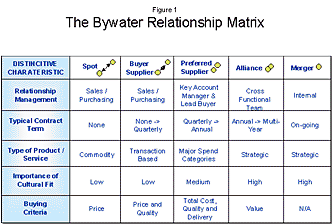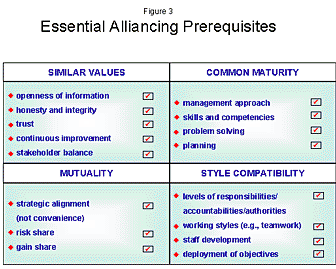|
Strategic Alliances –
Part One
Compoundings Magazine
October, 2001
By Thomas F. Glenn, Petroleum Trends International, Inc.
and Kevin J. Fiala, Bywater Corporate Development
This two-part article, written
by PetroTrends and its alliance partner Bywater Corporate Development
Services, provides information on what alliances are and how independent
lubricant manufacturers can use them to grow their businesses. Part
I focuses on the concepts of alliances. Part II bring the issue
home, and speaks directly to how independent lubricant manufacturers
can make alliances work for them.
The lubricants business continues
to move through a period of unprecedented change. One of the most
significant changes, and certainly the one expected to have the
most profound impact on the market, is consolidation. The number
of major lubricant manufacturers has shrunk from 14 to 9 in less
than 10 years. Virtually all of the consolidation has been the result
of mega-mergers and more are expected.
In addition to the impact of mega-mergers,
the lubricants industry is being reshaped by the Internet, increasingly
challenging lubricant performance specifications, new engine technology,
step changes in base stock manufacturing technology, fill-for-life
and extended drains, globalization, a softening economy, and other
issues. With these changes come significant challenges for independent
lubricant manufacturers. Independents are faced with more intense
competition, compressed margins, fewer choices in base stock sourcing,
and escalating costs, to name a few. But the changes also open the
doors of opportunity for independents, and strategic alliances offer
the keys to opening some of these doors.
Strategic alliances are often a much more flexible, less risky and
more cost effective strategy for independents lubricant manufacturers
to pursue when venturing into new markets and products/services,
and for broadening ones knowledgebase and improving performance
than are traditional mergers and acquisitions. They offer
particularly attractive solutions when there are strategic gaps
in critical differential capabilities that are too expensive or
will take too long to develop internally.
Two of the most common reasons
for forming alliances are to enhance growth and to gain access to
core capabilities. And for these reasons, strategic alliances are
being used widely, and at an accelerating rate. According to a recent
survey by consulting firm Booz-Allen & Hamilton, more than 20,000
alliances have been formed worldwide in the last two years alone.
In addition, more than 20% of the revenue generated from the top
2,000 US and European companies now comes from alliances, up from
about 5% in the early 1990’s, with more predicted in the near
future.
What they are and are not…
Forming successful business alliances
starts with understanding what alliances are, and what they are
not, and how they differ from mergers and acquisitions, key account
management, and outsourcing. A simple way to differentiate
alliances from other business relationships is by looking at The
Bywater Relationship Matrix in Figure
1 – a tool for evaluating how two companies trade with each
other.

Whether you call it an alliance or a partnership,
a useful definition for what alliances are is explained by Kevin
Fiala, principal of Bywater Corporate Development Services as “The
seamless operation of business processes to best apply the competence
of partners for shared gain. Fiala notes “alliances typically
form when one company alone can not effectively fill the gap in
serving the needs of the marketplace.”
Alliances are fundamentally different from acquisitions
and require a different level of understanding. Fiala draws from
Bywater’s experience in both alliances and acquisitions, and
notes, “while achieving control, acquisition brings to the
buyer all parts of the acquired entity – both strengths and
flaws – while alliances match strengths and balance control
with collaboration.” As The Bywater Relationship Matrix shows,
however, alliancing and acquisitions are not the only type of business
relationships. Perhaps the other most talked about model is that
of outsourcing. Rather than debating which approach to a business
relationship is best, however, PetroTrends and Bywater’s research
on alliances has shown that alliances and outsourcing each have
its place. The key question, therefore, is which one to use and
when. A simple way of looking at this is to consider the strategic
importance of the activity in question, and the firm’s competency
to deliver it. This approach, shown in Figure 2, demonstrates that
outsourcing is a potential relationship type in the preferred supplier
category.

The best way to separate those candidates for
outsourcing, as opposed to alliancing, is to consider their core
role. For outsourcing, think managed for cost. For alliancing, think
managed for value. Outsourced activities tend to be tactical in
nature, of low complexity, for which there are many providers. In
the lubricants industry an example of this could be an independent
lubricant manufacturer providing contract blending/toll manufacturing
for a major lubricant marketer. Alliance candidates, on the other
hand, are those where the supplier has a direct impact on the strategic
priorities of the buyer’s business, and where the mutual trust
and knowledge required by the supplier to add real value to the
customer cannot be replaced easily.
There are many cases of companies trying to
go down the alliancing route with suppliers they should really be
looking to outsource to. Similarly, and more significantly,
firms have outsourced activities that were strategic. Only later,
do they find that their strategic objectives cannot be achieved,
because they have lost the ability to direct activities that are
needed to support them.
The Business Need
Identifying the business need for an alliance
is the single most important, yet often most overlooked factor in
determining the success of an alliance. The process of overlooking
this pivotal issue typically plays out when one party – a customer
for example, proposes an alliance. A supplier then agrees to enter
into an alliance because they “feel” it’s the right
way to go or because “it’s their customer” and there
doesn’t seem to be an acceptable alternative response to the
invitation. All to infrequently do suppliers enter into an alliance
because they too see a compelling business benefit. Based on research
conducted by PetroTrends and Bywater’s on alliancing, there
are 24 critical factors for success in alliancing. Identifying and
understanding the business need for the alliance is at the top of
the list. As a result, before setting off on the alliancing journey,
each potential participant needs to critically ask the question:
Why am I doing this? There must be a clear understanding of what
the business need is. For example:
• Developing new markets, products, or
services
• Accessing new product innovation
• Funding constraints
• Broadening knowledgebase
• Reducing cost
• Controlling channels of supply or sales
• Locking competitors out of a relationship
The other question to ask, before pulling away
from the start line is: Am I ready, and are they? Distilling the
lessons learned from alliancing experience in a variety of industries
leads to a list of essential prerequisites for alliancing to succeed,
as shown in Figure 3.

Adding to the prerequisites for success, we have found that alliances
are most often driven by individuals and work best when not overly
complicated. The principles of most alliance can be captured in
two or three pages, frequently in a document as simple as a memorandum
of understanding (MOU). Alliance agreements that consists of 20
pages and full of legalize frequently suggest underlying questions
of trust and/or clarity of purpose. Complicated agreements
are all too often doomed for failure before the ink dries.
No pain, no gain…
Alliancing is also about shared pain to deliver
shared gain. So before the pain starts, a foundation of shared goals
and shared values is needed to assure shared gains. There are many
ways to develop the shared goals. The single most important test
of those stated goals, however, is that they fully align back to
the goals of the individual organizations. Which often make each
company’s strategic plan a good place to start in identifying
shared goals.
By having each company write on one sheet of paper their objectives
and critical success factors (for the company, not the alliance),
a “checklist” is created to ensure goal congruence.
If the two statements of purpose are then brought together, areas
of common interest, and conflict, can be identified. From this basis,
a set of truly aligned goals can be developed for the alliance,
which can lead to concrete targets.
Shared values is a topic which all too often
goes into the “too difficult” box, and yet is probably
the single greatest reason why alliances do not deliver the value
they should. A cultural assessment is a good place to start. After
all, if an entrepreneurial firm is trying to Tango with a hierarchical
firm doing the Foxtrot, it’s good to know that up front.
So, What Next?
Whether you are about to embark, are on the
road, or just pulling in for your first pit stop, the critical factor
in alliancing is recognizing it is a journey, not a one off project.
And to embark on a journey, you must have a map, and have shown
it to your fellow travelers. As with all journeys, you are never
quite sure what you will find along the way, even if you have a
clear view of where you are heading. That is why establishing mutual
trust, understanding and confidence with your fellow companions
is key before ever setting off.
Part II of this series on alliances will speak
to some of the destinations an independent lubricant manufacture
can travel to.
Copyright © Petroleum Trends International,
Inc.- Bywater Alliance. 2002
|
